MERCEDES-BENZ SPRINTER 2006 Service Manual
Manufacturer: MERCEDES-BENZ, Model Year: 2006, Model line: SPRINTER, Model: MERCEDES-BENZ SPRINTER 2006Pages: 2305, PDF Size: 48.12 MB
Page 2241 of 2305
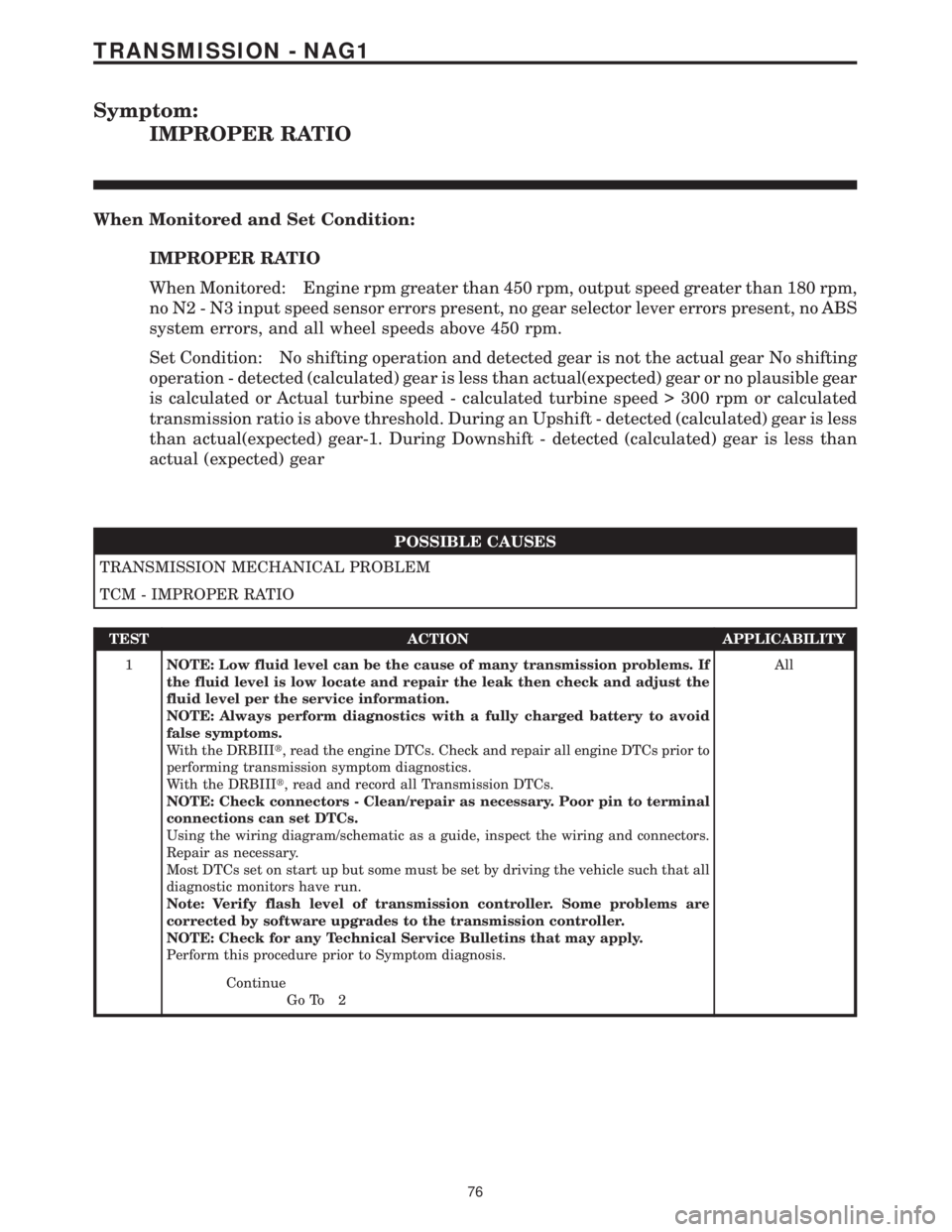
Symptom:
IMPROPER RATIO
When Monitored and Set Condition:
IMPROPER RATIO
When Monitored: Engine rpm greater than 450 rpm, output speed greater than 180 rpm,
no N2 - N3 input speed sensor errors present, no gear selector lever errors present, no ABS
system errors, and all wheel speeds above 450 rpm.
Set Condition: No shifting operation and detected gear is not the actual gear No shifting
operation - detected (calculated) gear is less than actual(expected) gear or no plausible gear
is calculated or Actual turbine speed - calculated turbine speed > 300 rpm or calculated
transmission ratio is above threshold. During an Upshift - detected (calculated) gear is less
than actual(expected) gear-1. During Downshift - detected (calculated) gear is less than
actual (expected) gear
POSSIBLE CAUSES
TRANSMISSION MECHANICAL PROBLEM
TCM - IMPROPER RATIO
TEST ACTION APPLICABILITY
1NOTE: Low fluid level can be the cause of many transmission problems. If
the fluid level is low locate and repair the leak then check and adjust the
fluid level per the service information.
NOTE: Always perform diagnostics with a fully charged battery to avoid
false symptoms.
With the DRBIIIt, read the engine DTCs. Check and repair all engine DTCs prior to
performing transmission symptom diagnostics.
With the DRBIIIt, read and record all Transmission DTCs.
NOTE: Check connectors - Clean/repair as necessary. Poor pin to terminal
connections can set DTCs.
Using the wiring diagram/schematic as a guide, inspect the wiring and connectors.
Repair as necessary.
Most DTCs set on start up but some must be set by driving the vehicle such that all
diagnostic monitors have run.
Note: Verify flash level of transmission controller. Some problems are
corrected by software upgrades to the transmission controller.
NOTE: Check for any Technical Service Bulletins that may apply.
Perform this procedure prior to Symptom diagnosis.All
Continue
Go To 2
76
TRANSMISSION - NAG1
Page 2242 of 2305
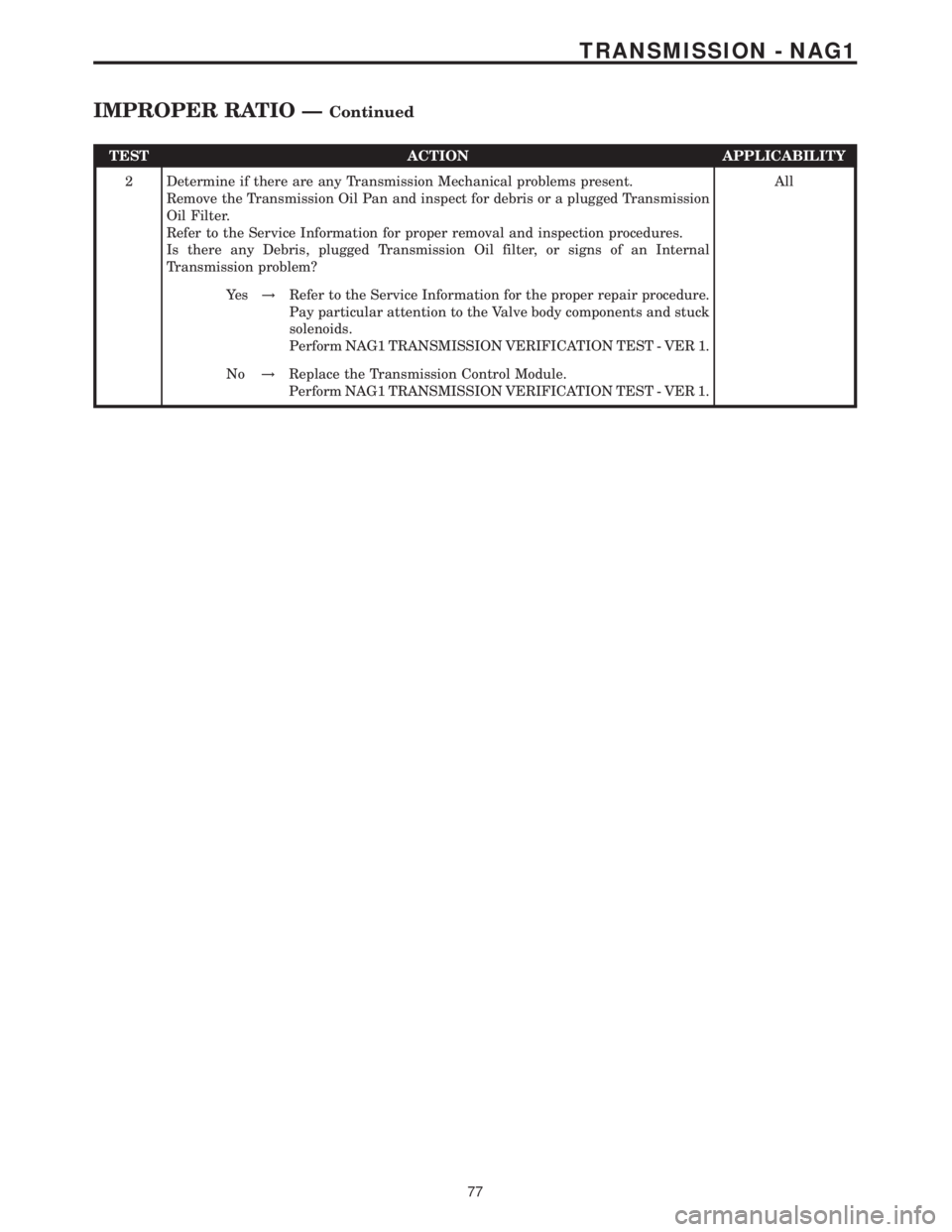
TEST ACTION APPLICABILITY
2 Determine if there are any Transmission Mechanical problems present.
Remove the Transmission Oil Pan and inspect for debris or a plugged Transmission
Oil Filter.
Refer to the Service Information for proper removal and inspection procedures.
Is there any Debris, plugged Transmission Oil filter, or signs of an Internal
Transmission problem?All
Ye s!Refer to the Service Information for the proper repair procedure.
Pay particular attention to the Valve body components and stuck
solenoids.
Perform NAG1 TRANSMISSION VERIFICATION TEST - VER 1.
No!Replace the Transmission Control Module.
Perform NAG1 TRANSMISSION VERIFICATION TEST - VER 1.
77
TRANSMISSION - NAG1
IMPROPER RATIO ÐContinued
Page 2243 of 2305
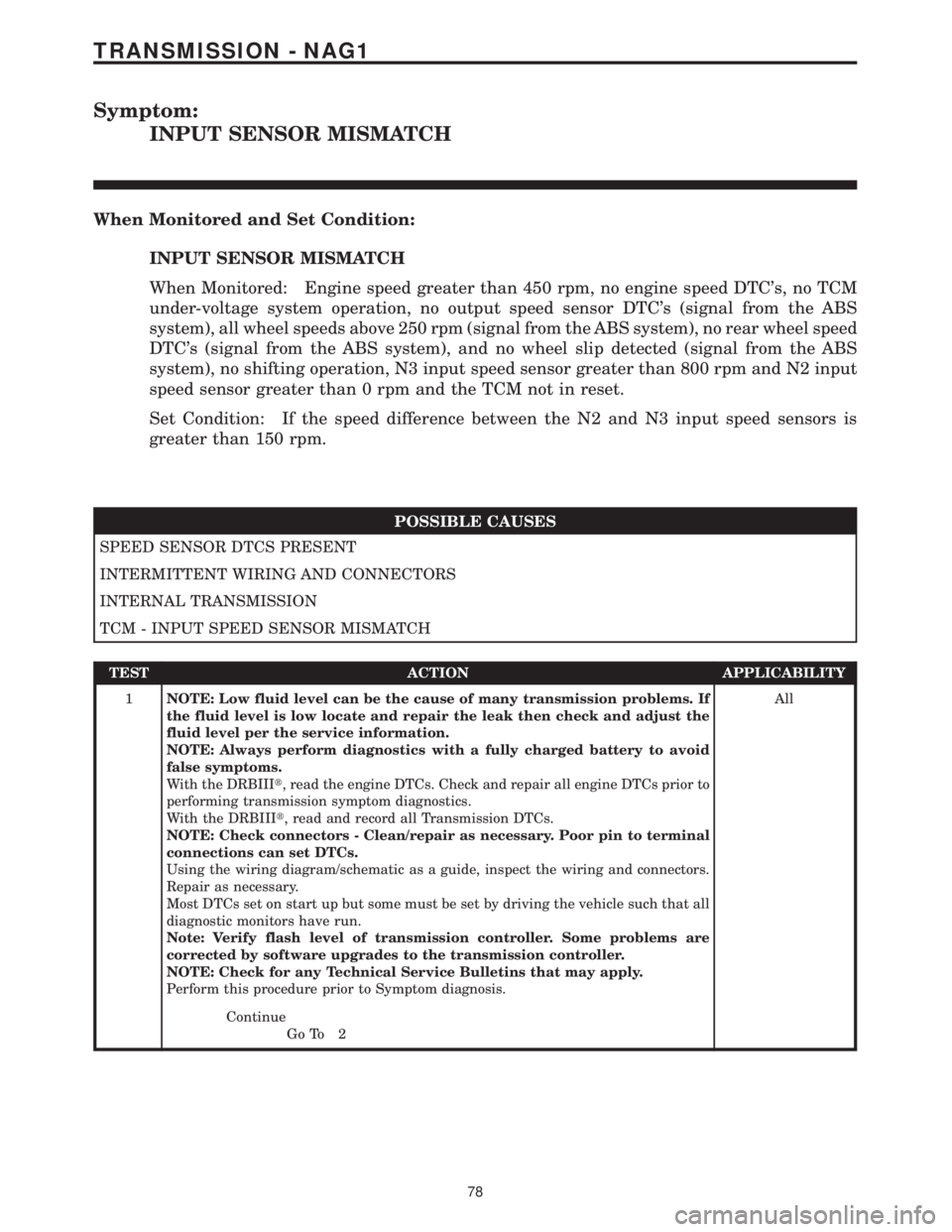
Symptom:
INPUT SENSOR MISMATCH
When Monitored and Set Condition:
INPUT SENSOR MISMATCH
When Monitored: Engine speed greater than 450 rpm, no engine speed DTC's, no TCM
under-voltage system operation, no output speed sensor DTC's (signal from the ABS
system), all wheel speeds above 250 rpm (signal from the ABS system), no rear wheel speed
DTC's (signal from the ABS system), and no wheel slip detected (signal from the ABS
system), no shifting operation, N3 input speed sensor greater than 800 rpm and N2 input
speed sensor greater than 0 rpm and the TCM not in reset.
Set Condition: If the speed difference between the N2 and N3 input speed sensors is
greater than 150 rpm.
POSSIBLE CAUSES
SPEED SENSOR DTCS PRESENT
INTERMITTENT WIRING AND CONNECTORS
INTERNAL TRANSMISSION
TCM - INPUT SPEED SENSOR MISMATCH
TEST ACTION APPLICABILITY
1NOTE: Low fluid level can be the cause of many transmission problems. If
the fluid level is low locate and repair the leak then check and adjust the
fluid level per the service information.
NOTE: Always perform diagnostics with a fully charged battery to avoid
false symptoms.
With the DRBIIIt, read the engine DTCs. Check and repair all engine DTCs prior to
performing transmission symptom diagnostics.
With the DRBIIIt, read and record all Transmission DTCs.
NOTE: Check connectors - Clean/repair as necessary. Poor pin to terminal
connections can set DTCs.
Using the wiring diagram/schematic as a guide, inspect the wiring and connectors.
Repair as necessary.
Most DTCs set on start up but some must be set by driving the vehicle such that all
diagnostic monitors have run.
Note: Verify flash level of transmission controller. Some problems are
corrected by software upgrades to the transmission controller.
NOTE: Check for any Technical Service Bulletins that may apply.
Perform this procedure prior to Symptom diagnosis.All
Continue
Go To 2
78
TRANSMISSION - NAG1
Page 2244 of 2305
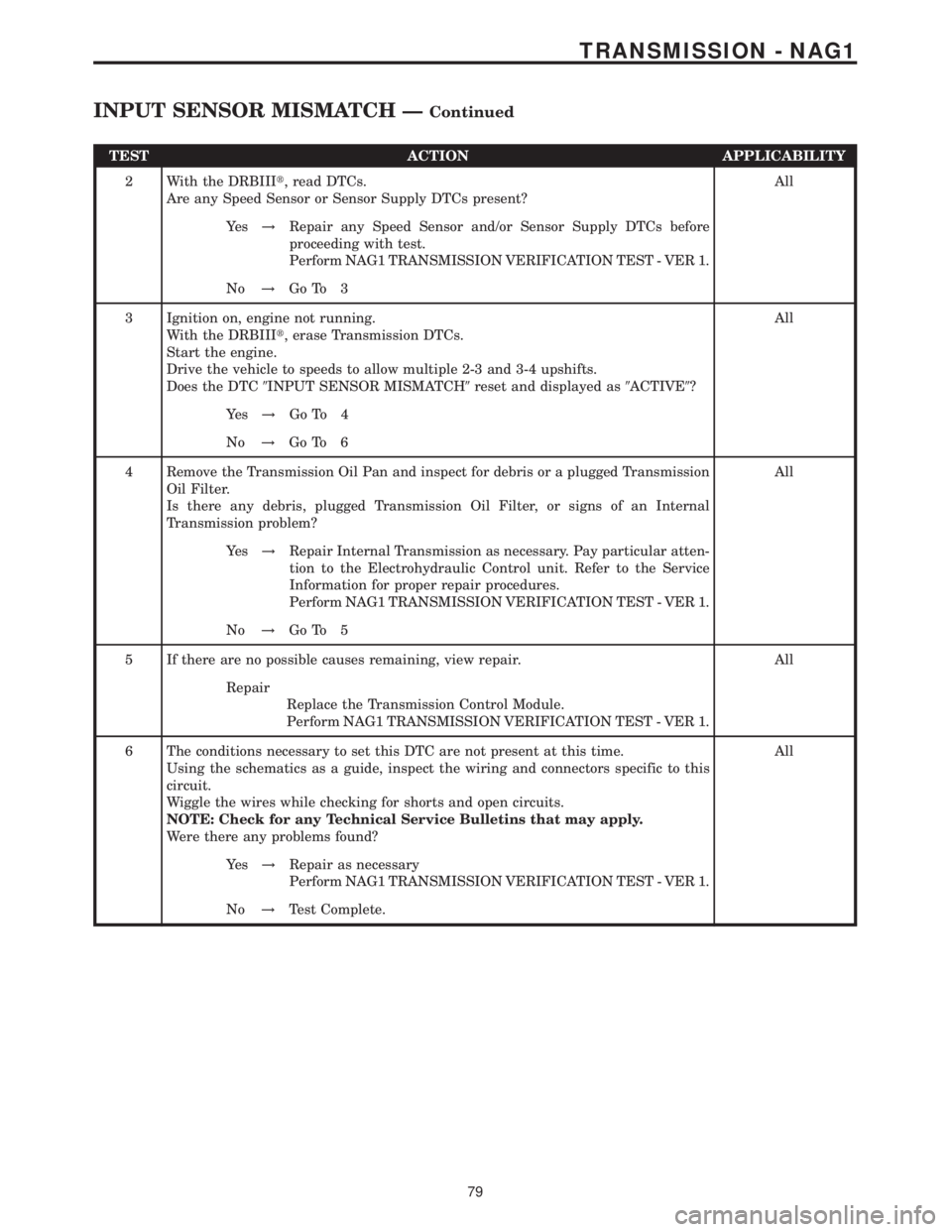
TEST ACTION APPLICABILITY
2 With the DRBIIIt, read DTCs.
Are any Speed Sensor or Sensor Supply DTCs present?All
Ye s!Repair any Speed Sensor and/or Sensor Supply DTCs before
proceeding with test.
Perform NAG1 TRANSMISSION VERIFICATION TEST - VER 1.
No!Go To 3
3 Ignition on, engine not running.
With the DRBIIIt, erase Transmission DTCs.
Start the engine.
Drive the vehicle to speeds to allow multiple 2-3 and 3-4 upshifts.
Does the DTC9INPUT SENSOR MISMATCH9reset and displayed as9ACTIVE9?All
Ye s!Go To 4
No!Go To 6
4 Remove the Transmission Oil Pan and inspect for debris or a plugged Transmission
Oil Filter.
Is there any debris, plugged Transmission Oil Filter, or signs of an Internal
Transmission problem?All
Ye s!Repair Internal Transmission as necessary. Pay particular atten-
tion to the Electrohydraulic Control unit. Refer to the Service
Information for proper repair procedures.
Perform NAG1 TRANSMISSION VERIFICATION TEST - VER 1.
No!Go To 5
5 If there are no possible causes remaining, view repair. All
Repair
Replace the Transmission Control Module.
Perform NAG1 TRANSMISSION VERIFICATION TEST - VER 1.
6 The conditions necessary to set this DTC are not present at this time.
Using the schematics as a guide, inspect the wiring and connectors specific to this
circuit.
Wiggle the wires while checking for shorts and open circuits.
NOTE: Check for any Technical Service Bulletins that may apply.
Were there any problems found?All
Ye s!Repair as necessary
Perform NAG1 TRANSMISSION VERIFICATION TEST - VER 1.
No!Test Complete.
79
TRANSMISSION - NAG1
INPUT SENSOR MISMATCH ÐContinued
Page 2245 of 2305
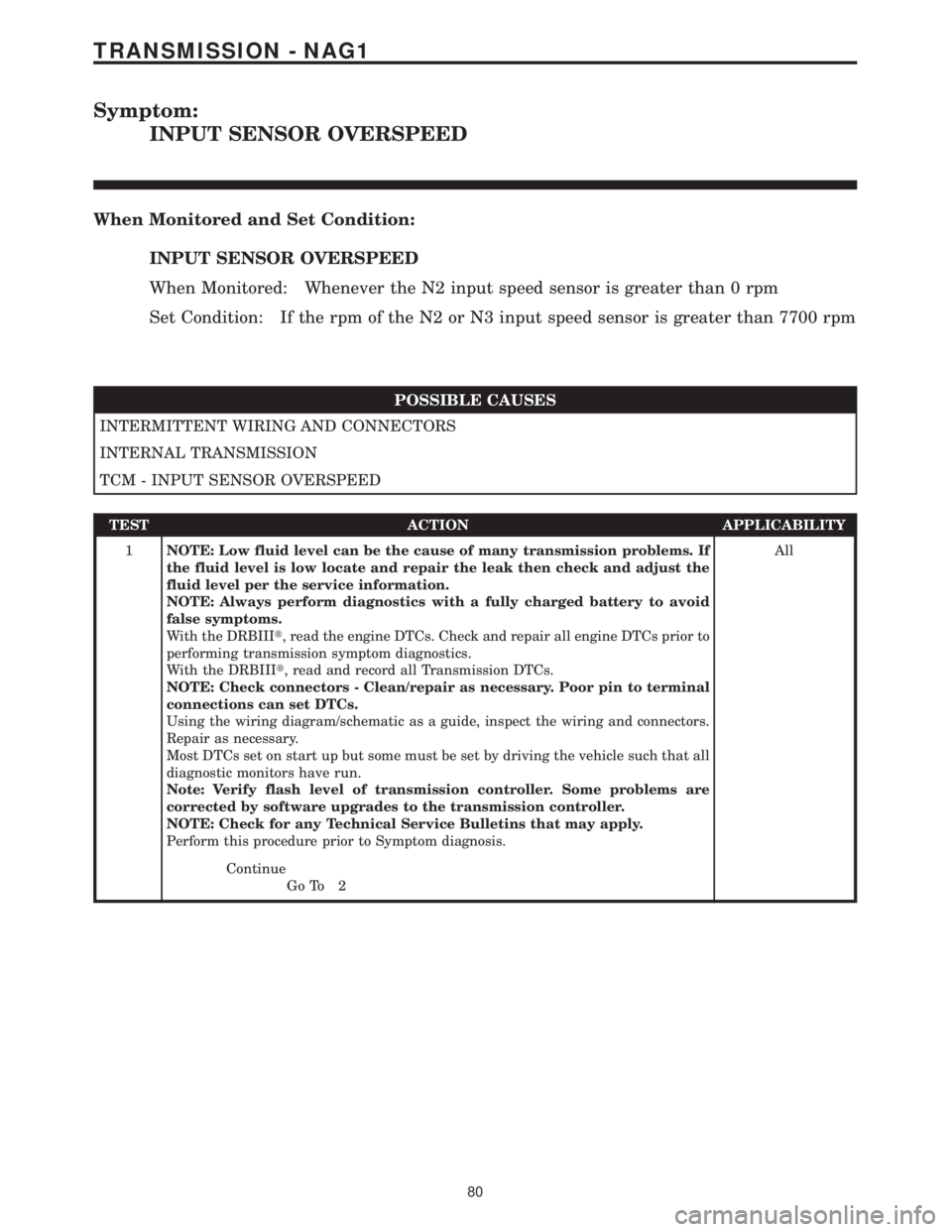
Symptom:
INPUT SENSOR OVERSPEED
When Monitored and Set Condition:
INPUT SENSOR OVERSPEED
When Monitored: Whenever the N2 input speed sensor is greater than 0 rpm
Set Condition: If the rpm of the N2 or N3 input speed sensor is greater than 7700 rpm
POSSIBLE CAUSES
INTERMITTENT WIRING AND CONNECTORS
INTERNAL TRANSMISSION
TCM - INPUT SENSOR OVERSPEED
TEST ACTION APPLICABILITY
1NOTE: Low fluid level can be the cause of many transmission problems. If
the fluid level is low locate and repair the leak then check and adjust the
fluid level per the service information.
NOTE: Always perform diagnostics with a fully charged battery to avoid
false symptoms.
With the DRBIIIt, read the engine DTCs. Check and repair all engine DTCs prior to
performing transmission symptom diagnostics.
With the DRBIIIt, read and record all Transmission DTCs.
NOTE: Check connectors - Clean/repair as necessary. Poor pin to terminal
connections can set DTCs.
Using the wiring diagram/schematic as a guide, inspect the wiring and connectors.
Repair as necessary.
Most DTCs set on start up but some must be set by driving the vehicle such that all
diagnostic monitors have run.
Note: Verify flash level of transmission controller. Some problems are
corrected by software upgrades to the transmission controller.
NOTE: Check for any Technical Service Bulletins that may apply.
Perform this procedure prior to Symptom diagnosis.All
Continue
Go To 2
80
TRANSMISSION - NAG1
Page 2246 of 2305
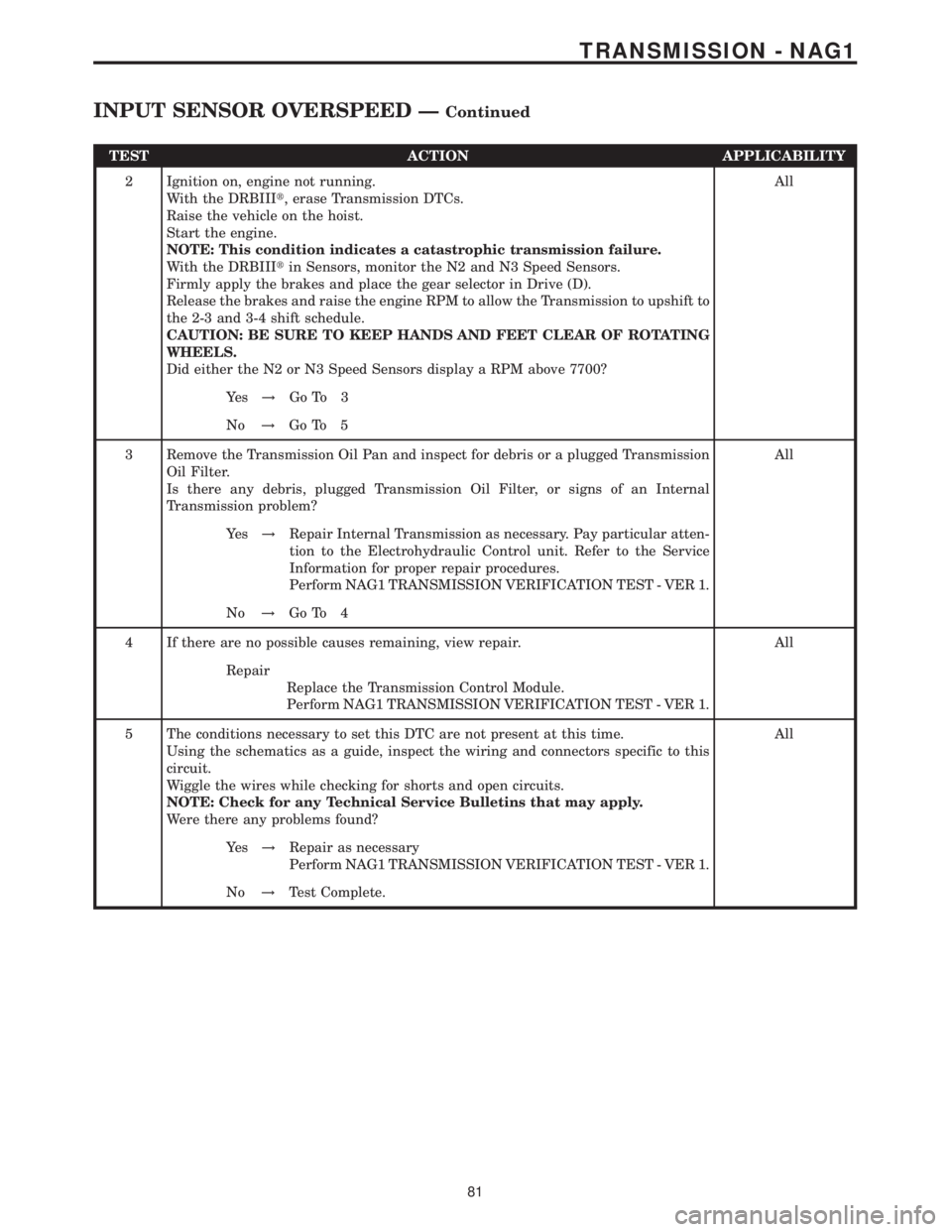
TEST ACTION APPLICABILITY
2 Ignition on, engine not running.
With the DRBIIIt, erase Transmission DTCs.
Raise the vehicle on the hoist.
Start the engine.
NOTE: This condition indicates a catastrophic transmission failure.
With the DRBIIItin Sensors, monitor the N2 and N3 Speed Sensors.
Firmly apply the brakes and place the gear selector in Drive (D).
Release the brakes and raise the engine RPM to allow the Transmission to upshift to
the 2-3 and 3-4 shift schedule.
CAUTION: BE SURE TO KEEP HANDS AND FEET CLEAR OF ROTATING
WHEELS.
Did either the N2 or N3 Speed Sensors display a RPM above 7700?All
Ye s!Go To 3
No!Go To 5
3 Remove the Transmission Oil Pan and inspect for debris or a plugged Transmission
Oil Filter.
Is there any debris, plugged Transmission Oil Filter, or signs of an Internal
Transmission problem?All
Ye s!Repair Internal Transmission as necessary. Pay particular atten-
tion to the Electrohydraulic Control unit. Refer to the Service
Information for proper repair procedures.
Perform NAG1 TRANSMISSION VERIFICATION TEST - VER 1.
No!Go To 4
4 If there are no possible causes remaining, view repair. All
Repair
Replace the Transmission Control Module.
Perform NAG1 TRANSMISSION VERIFICATION TEST - VER 1.
5 The conditions necessary to set this DTC are not present at this time.
Using the schematics as a guide, inspect the wiring and connectors specific to this
circuit.
Wiggle the wires while checking for shorts and open circuits.
NOTE: Check for any Technical Service Bulletins that may apply.
Were there any problems found?All
Ye s!Repair as necessary
Perform NAG1 TRANSMISSION VERIFICATION TEST - VER 1.
No!Test Complete.
81
TRANSMISSION - NAG1
INPUT SENSOR OVERSPEED ÐContinued
Page 2247 of 2305
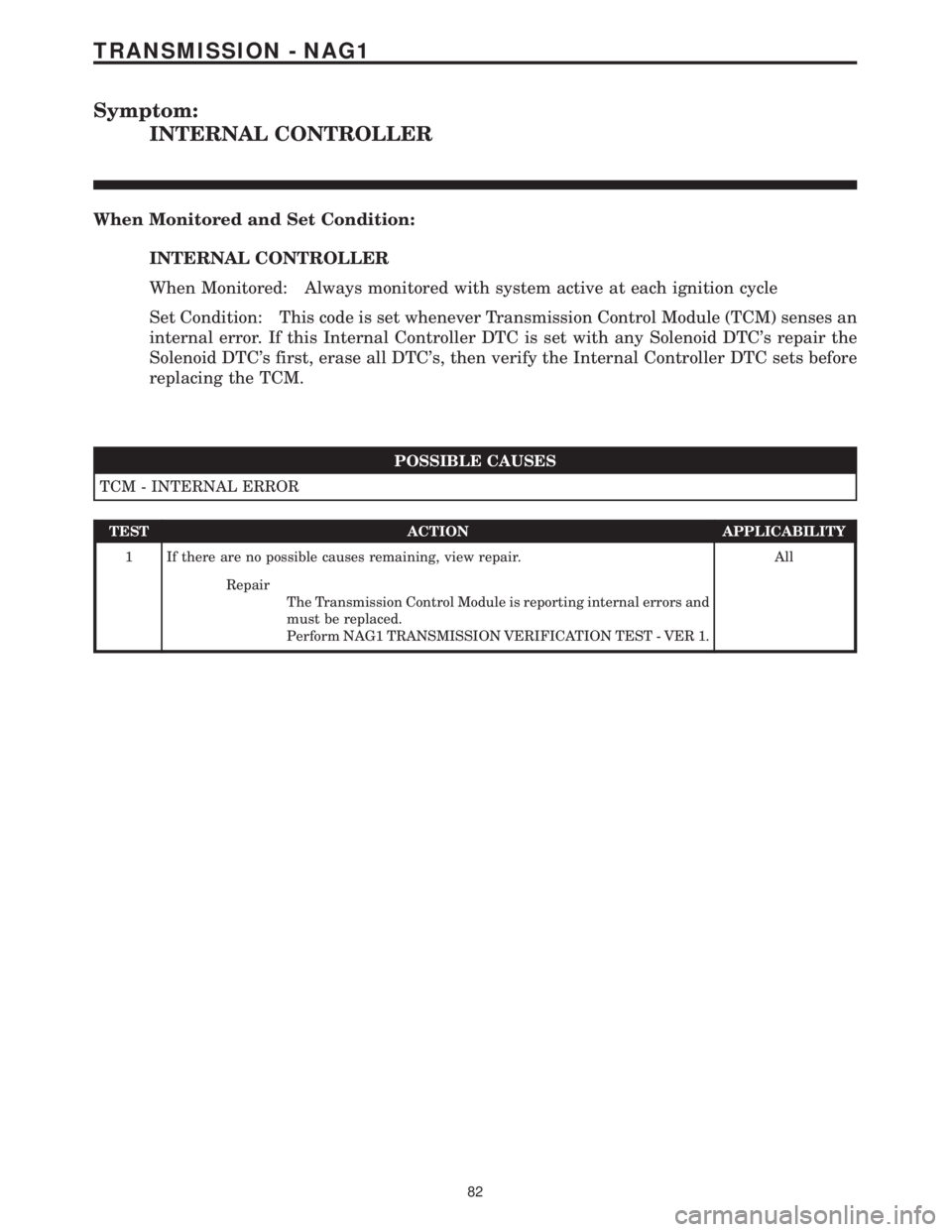
Symptom:
INTERNAL CONTROLLER
When Monitored and Set Condition:
INTERNAL CONTROLLER
When Monitored: Always monitored with system active at each ignition cycle
Set Condition: This code is set whenever Transmission Control Module (TCM) senses an
internal error. If this Internal Controller DTC is set with any Solenoid DTC's repair the
Solenoid DTC's first, erase all DTC's, then verify the Internal Controller DTC sets before
replacing the TCM.
POSSIBLE CAUSES
TCM - INTERNAL ERROR
TEST ACTION APPLICABILITY
1 If there are no possible causes remaining, view repair. All
Repair
The Transmission Control Module is reporting internal errors and
must be replaced.
Perform NAG1 TRANSMISSION VERIFICATION TEST - VER 1.
82
TRANSMISSION - NAG1
Page 2248 of 2305
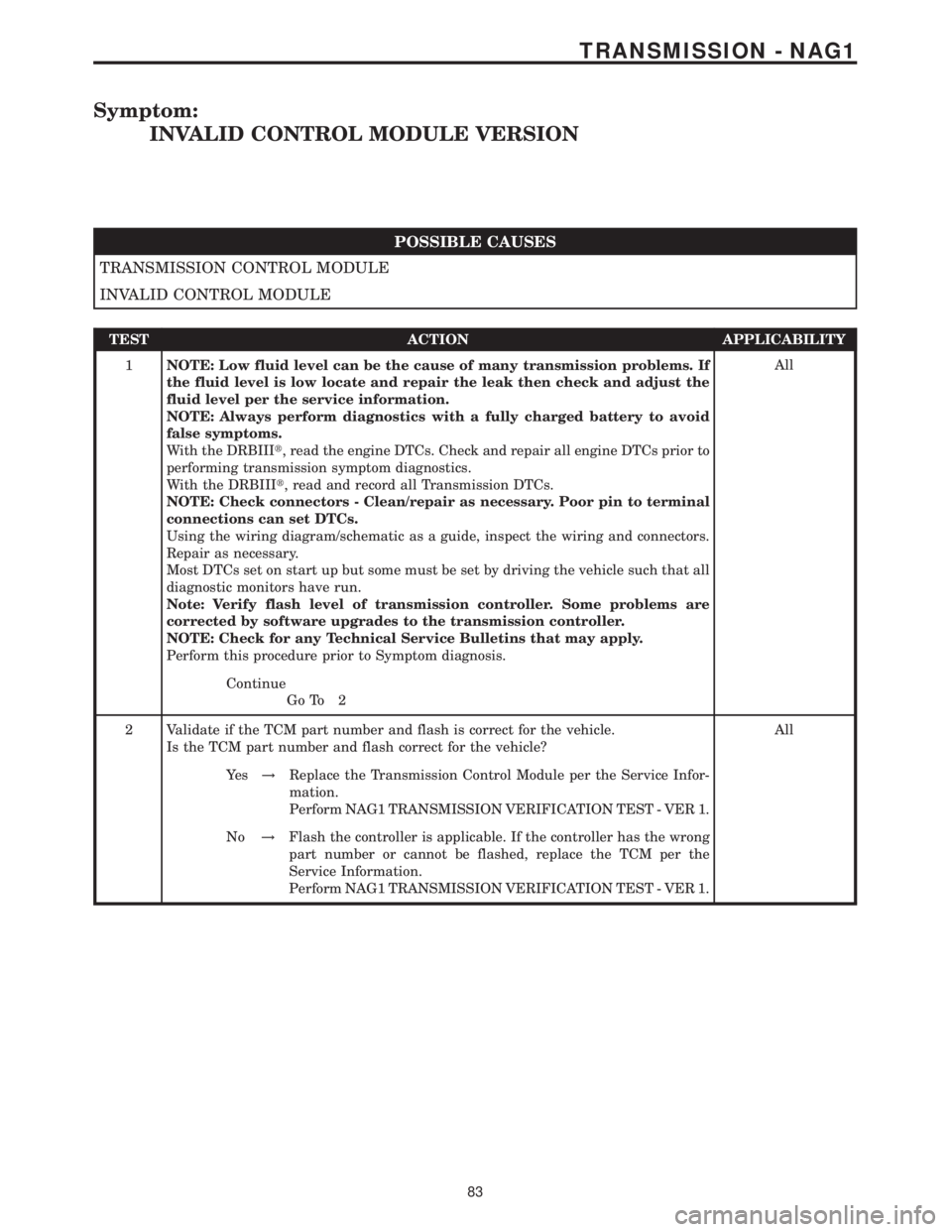
Symptom:
INVALID CONTROL MODULE VERSION
POSSIBLE CAUSES
TRANSMISSION CONTROL MODULE
INVALID CONTROL MODULE
TEST ACTION APPLICABILITY
1NOTE: Low fluid level can be the cause of many transmission problems. If
the fluid level is low locate and repair the leak then check and adjust the
fluid level per the service information.
NOTE: Always perform diagnostics with a fully charged battery to avoid
false symptoms.
With the DRBIIIt, read the engine DTCs. Check and repair all engine DTCs prior to
performing transmission symptom diagnostics.
With the DRBIIIt, read and record all Transmission DTCs.
NOTE: Check connectors - Clean/repair as necessary. Poor pin to terminal
connections can set DTCs.
Using the wiring diagram/schematic as a guide, inspect the wiring and connectors.
Repair as necessary.
Most DTCs set on start up but some must be set by driving the vehicle such that all
diagnostic monitors have run.
Note: Verify flash level of transmission controller. Some problems are
corrected by software upgrades to the transmission controller.
NOTE: Check for any Technical Service Bulletins that may apply.
Perform this procedure prior to Symptom diagnosis.All
Continue
Go To 2
2 Validate if the TCM part number and flash is correct for the vehicle.
Is the TCM part number and flash correct for the vehicle?All
Ye s!Replace the Transmission Control Module per the Service Infor-
mation.
Perform NAG1 TRANSMISSION VERIFICATION TEST - VER 1.
No!Flash the controller is applicable. If the controller has the wrong
part number or cannot be flashed, replace the TCM per the
Service Information.
Perform NAG1 TRANSMISSION VERIFICATION TEST - VER 1.
83
TRANSMISSION - NAG1
Page 2249 of 2305
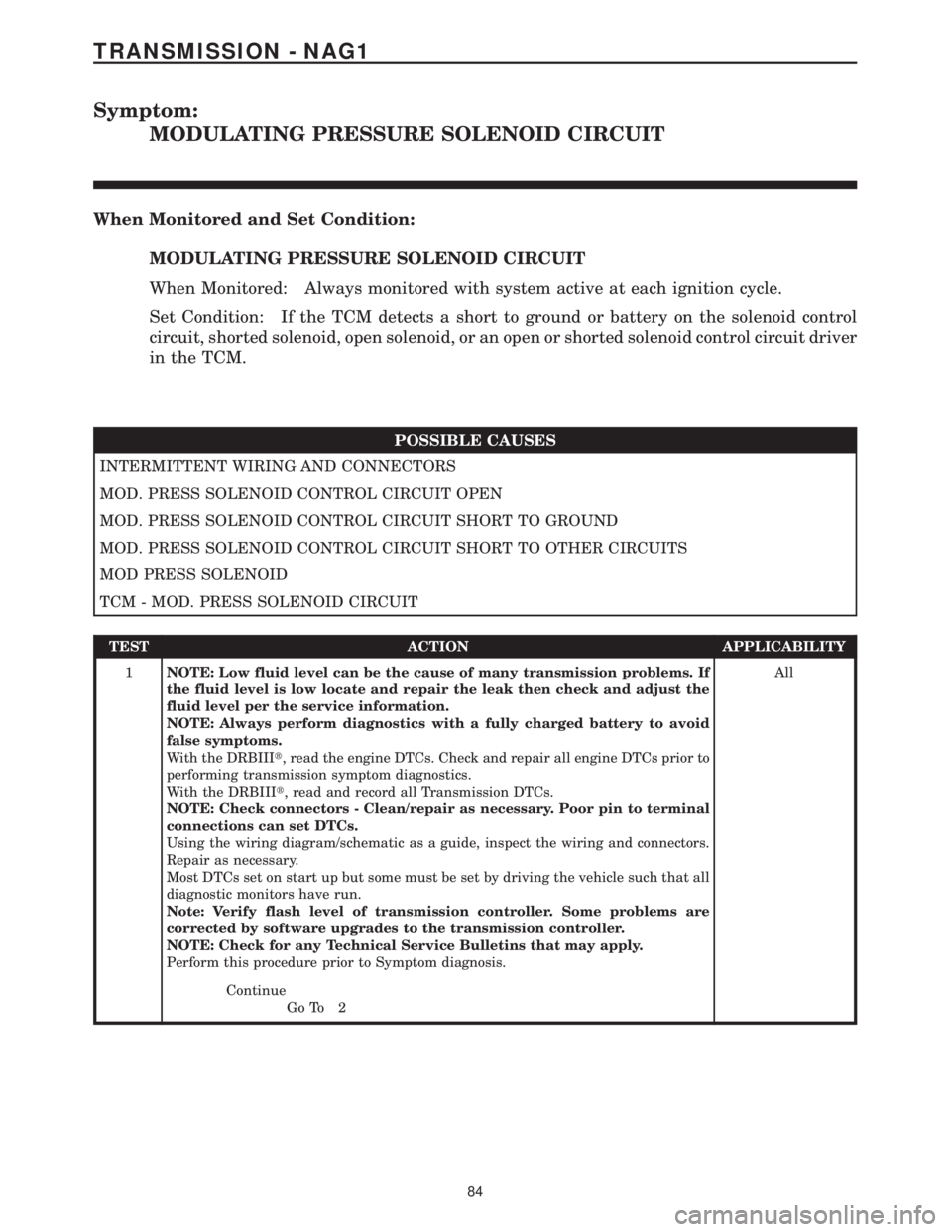
Symptom:
MODULATING PRESSURE SOLENOID CIRCUIT
When Monitored and Set Condition:
MODULATING PRESSURE SOLENOID CIRCUIT
When Monitored: Always monitored with system active at each ignition cycle.
Set Condition: If the TCM detects a short to ground or battery on the solenoid control
circuit, shorted solenoid, open solenoid, or an open or shorted solenoid control circuit driver
in the TCM.
POSSIBLE CAUSES
INTERMITTENT WIRING AND CONNECTORS
MOD. PRESS SOLENOID CONTROL CIRCUIT OPEN
MOD. PRESS SOLENOID CONTROL CIRCUIT SHORT TO GROUND
MOD. PRESS SOLENOID CONTROL CIRCUIT SHORT TO OTHER CIRCUITS
MOD PRESS SOLENOID
TCM - MOD. PRESS SOLENOID CIRCUIT
TEST ACTION APPLICABILITY
1NOTE: Low fluid level can be the cause of many transmission problems. If
the fluid level is low locate and repair the leak then check and adjust the
fluid level per the service information.
NOTE: Always perform diagnostics with a fully charged battery to avoid
false symptoms.
With the DRBIIIt, read the engine DTCs. Check and repair all engine DTCs prior to
performing transmission symptom diagnostics.
With the DRBIIIt, read and record all Transmission DTCs.
NOTE: Check connectors - Clean/repair as necessary. Poor pin to terminal
connections can set DTCs.
Using the wiring diagram/schematic as a guide, inspect the wiring and connectors.
Repair as necessary.
Most DTCs set on start up but some must be set by driving the vehicle such that all
diagnostic monitors have run.
Note: Verify flash level of transmission controller. Some problems are
corrected by software upgrades to the transmission controller.
NOTE: Check for any Technical Service Bulletins that may apply.
Perform this procedure prior to Symptom diagnosis.All
Continue
Go To 2
84
TRANSMISSION - NAG1
Page 2250 of 2305
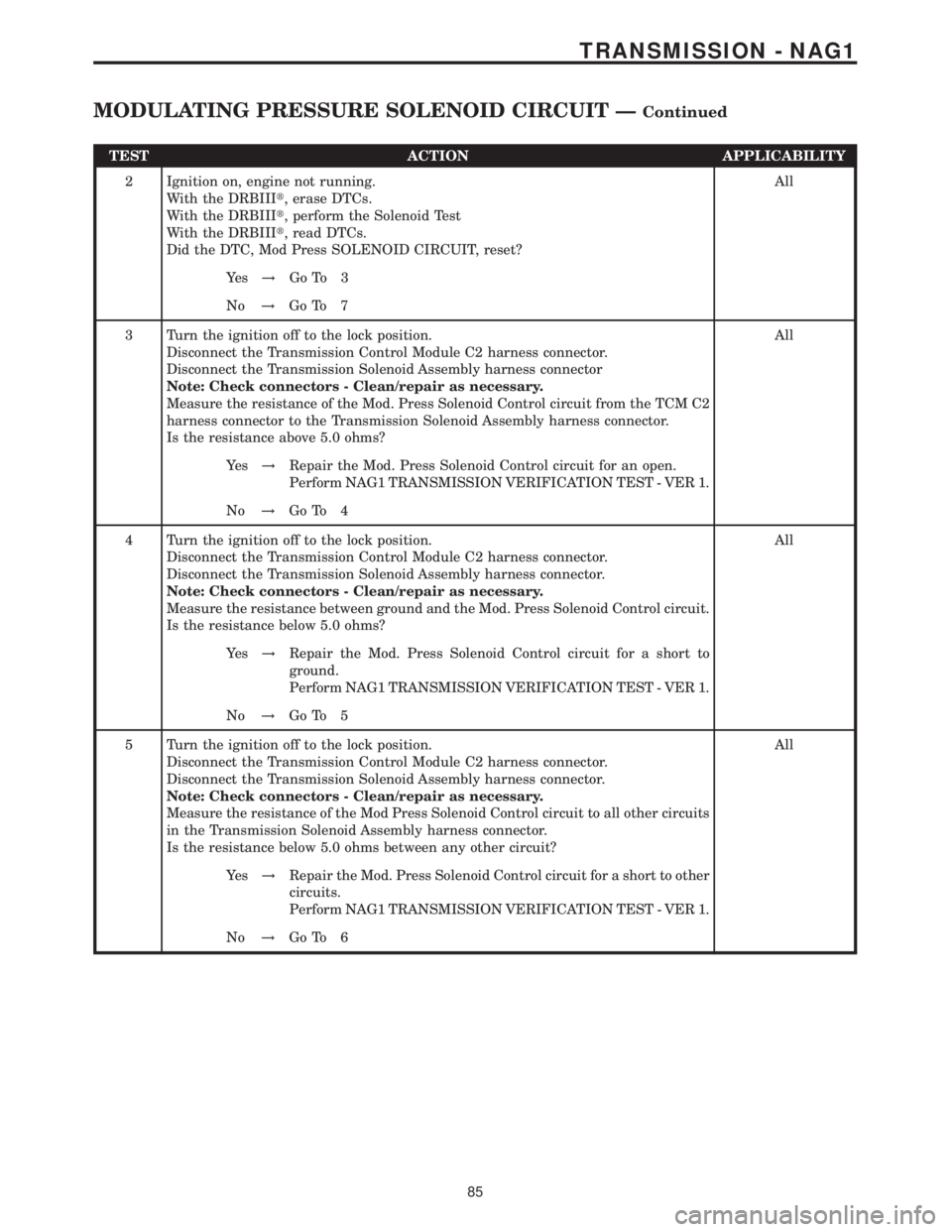
TEST ACTION APPLICABILITY
2 Ignition on, engine not running.
With the DRBIIIt, erase DTCs.
With the DRBIIIt, perform the Solenoid Test
With the DRBIIIt, read DTCs.
Did the DTC, Mod Press SOLENOID CIRCUIT, reset?All
Ye s!Go To 3
No!Go To 7
3 Turn the ignition off to the lock position.
Disconnect the Transmission Control Module C2 harness connector.
Disconnect the Transmission Solenoid Assembly harness connector
Note: Check connectors - Clean/repair as necessary.
Measure the resistance of the Mod. Press Solenoid Control circuit from the TCM C2
harness connector to the Transmission Solenoid Assembly harness connector.
Is the resistance above 5.0 ohms?All
Ye s!Repair the Mod. Press Solenoid Control circuit for an open.
Perform NAG1 TRANSMISSION VERIFICATION TEST - VER 1.
No!Go To 4
4 Turn the ignition off to the lock position.
Disconnect the Transmission Control Module C2 harness connector.
Disconnect the Transmission Solenoid Assembly harness connector.
Note: Check connectors - Clean/repair as necessary.
Measure the resistance between ground and the Mod. Press Solenoid Control circuit.
Is the resistance below 5.0 ohms?All
Ye s!Repair the Mod. Press Solenoid Control circuit for a short to
ground.
Perform NAG1 TRANSMISSION VERIFICATION TEST - VER 1.
No!Go To 5
5 Turn the ignition off to the lock position.
Disconnect the Transmission Control Module C2 harness connector.
Disconnect the Transmission Solenoid Assembly harness connector.
Note: Check connectors - Clean/repair as necessary.
Measure the resistance of the Mod Press Solenoid Control circuit to all other circuits
in the Transmission Solenoid Assembly harness connector.
Is the resistance below 5.0 ohms between any other circuit?All
Ye s!Repair the Mod. Press Solenoid Control circuit for a short to other
circuits.
Perform NAG1 TRANSMISSION VERIFICATION TEST - VER 1.
No!Go To 6
85
TRANSMISSION - NAG1
MODULATING PRESSURE SOLENOID CIRCUIT ÐContinued